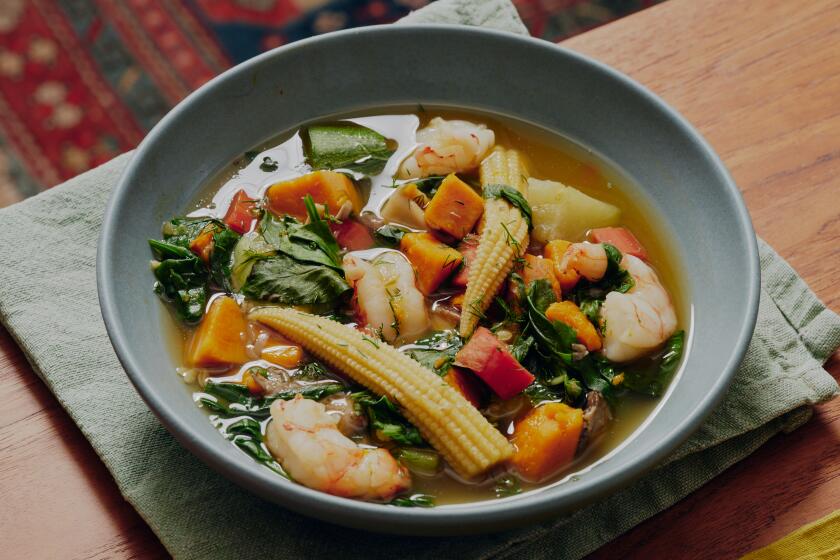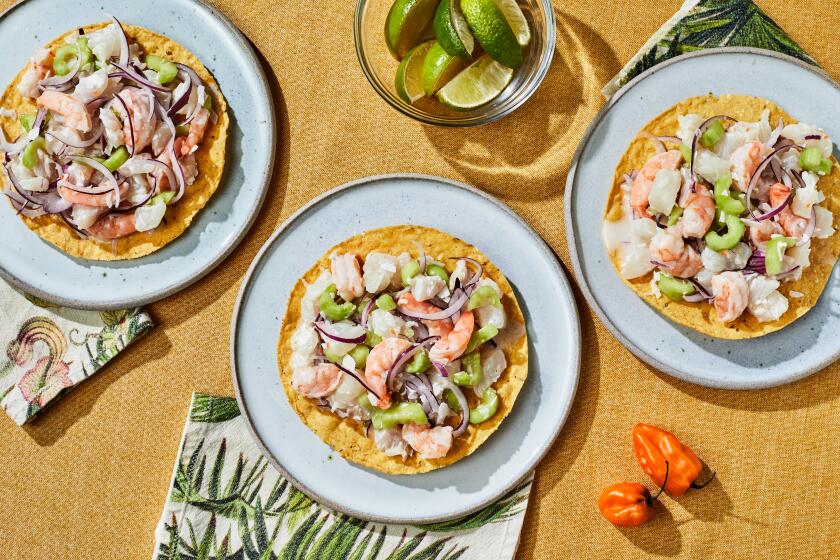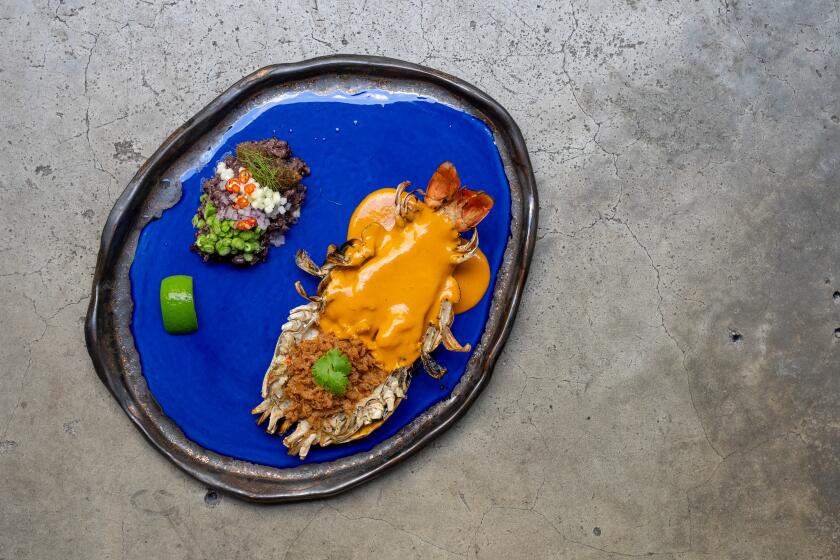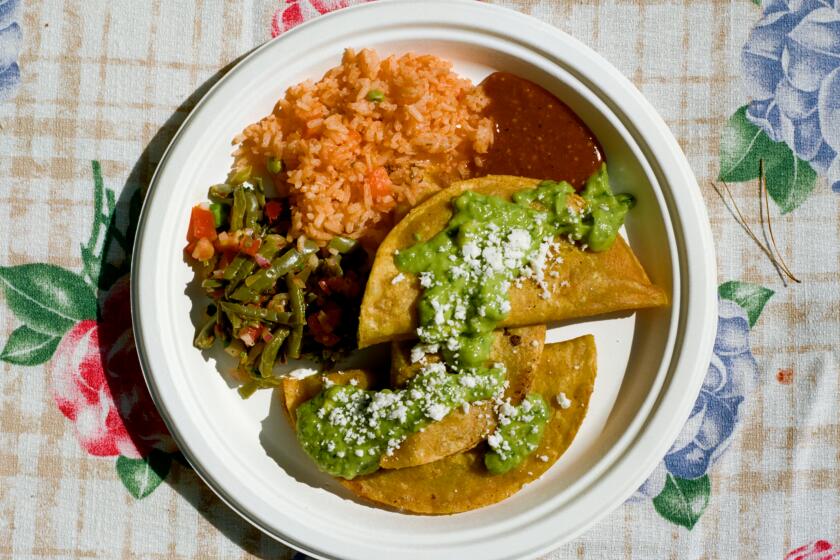Grilled Pacific spiny lobster
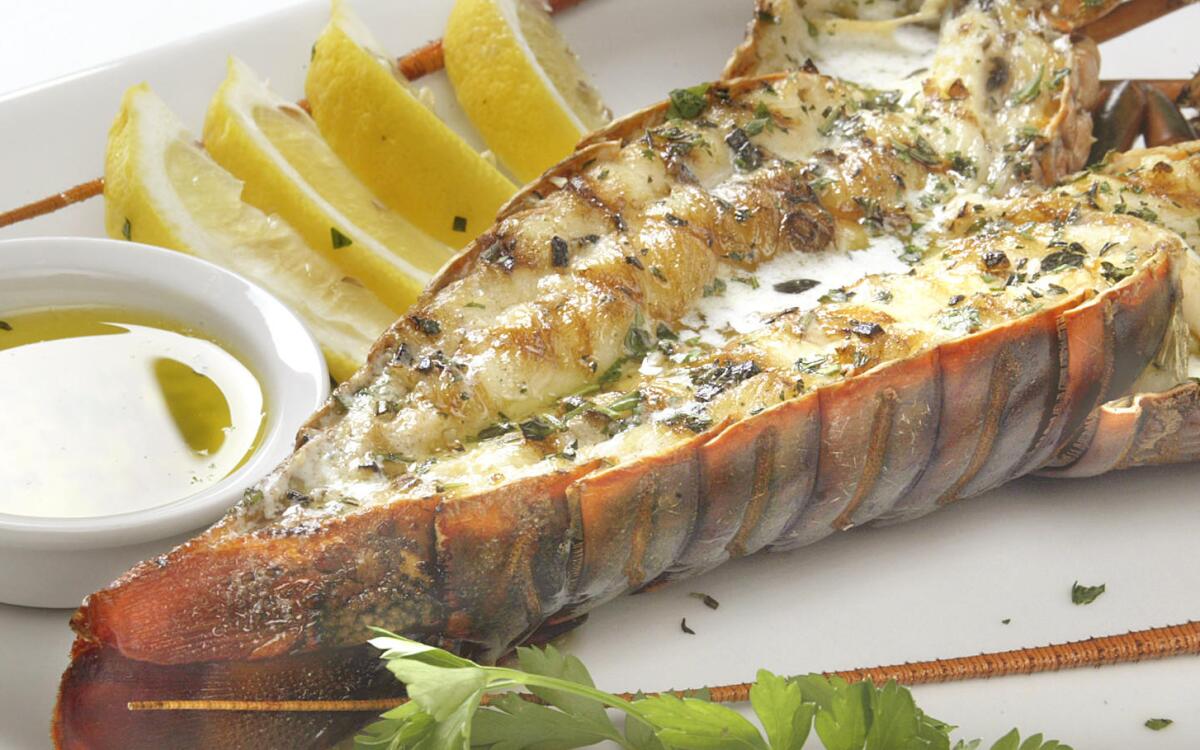
- Share via
LOBSTER is the very essence of luxury, one of the most sought-after foods in the world. Maine lobsters, with their giant sweet claws, are to many people the epitome of deliciousness. But we have something every bit as amazing swimming around right off our own shores, just waiting to be eaten.
Right now, with the commercial Southern California spiny lobster season at its peak, it is time to give the unsung local heroes their due -- preferably after a judicious grilling, and well slathered in herbed butter.
Spiny lobsters have a little firmer texture than Maine lobsters and a fuller, more complex flavor. And they are highly seasonal. The commercial harvest begins the first Wednesday of October, and though it lasts through mid-May, most of the catch occurs this month.
“People who know about them started coming in like a month ago asking ‘When will spiny season start?’ ” says chef Allyson Thurber, who is serving about 200 a day prepared just that way at the aptly named Lobster restaurant at the Santa Monica Pier.
Local spiny lobsters, found from Santa Barbara to the Gulf of Mexico, have to be one of the most underappreciated foods around. It is the rare and discerning chef who finds a place for them on the menu, and you may have to search a little to find a market that stocks them.
When the Redondo Beach Chamber of Commerce throws its annual Lobster Festival every September, it’s Maine lobster they serve, frozen and flown in from the East Coast. (Granted, it is hard to imagine spinys taking much offense at all this. They probably spend the festival weekend gathering in the eelgrass, chuckling among themselves -- spiny lobsters, biologists tell us, are “sociable and gregarious.”)
There are many types of spiny lobsters in the world; for the most part they differ only slightly. The one we get is Panulirus interruptus. Probably the best known in this country is the one from Florida (P. argus), which is smaller than the Californian (and usually sold frozen). There are also other spinys found farther down the Mexican coast. One particularly sought-after variety (P. inflatus) is commonly called the “blue bug” because of its distinctive coloring. The European spiny (P. elephas) is another relative.
The most noticeable difference between spiny lobsters and their East Coast cousins (Homarus americanus) is that spinys lack big front claws. You eat only the tail -- they’re more like giant shrimp.
That tail is bigger and much more muscular than homarus’. Whereas the East Coast lobster’s preferred mode of escape from threats is crawling, spinys flex their tails to swim very quickly backward. When in danger, they also like to burrow into rocky crevices, using their tails to lock themselves in and waving their long, barbed antennae for defense.
Former Water Grill chef Michael Cimarusti, whose next restaurant, Providence, will also focus on top-quality seafood, says these antennae can be every bit as dangerous as claws -- especially to the unwary.
“We’d get these 11-pounders and we’d always send the rookies to get them out of the tank,” Cimarusti says. “They don’t have claws, but they do have really sharp barbs on their antennae and they wave those back and forth. They will really tear you up if you’re not careful. And their tail is so strong, they’ll just clamp down on the bottom of the tank. If you don’t surprise them, it can seem almost impossible to pull them out.”
A headstrong tail
That powerful tail is the focus of a lot of attention when it comes to cooking. It must be prepared carefully to avoid toughening the muscle.
“It’s very easy to blow the texture on these things,” Cimarusti says. “If you undercook it, so the flesh is too translucent, the texture will be gummy. If you overcook it, it will be too chewy. It’s very difficult to get it exactly right.”
If you’re going to boil them, Cimarusti recommends maintaining the water at a bare simmer rather than a rolling boil. “That’s incredibly important,” he says.
Thurber goes so far as to say spinys should never be boiled at all. “We only grill them,” she says. “And we only cook them to about medium-rare. That way they’re beautiful; the meat pulls right out of the shell.”
The lobster is done, she says, when you can see the meat turn from translucent to nearly opaque, but with a trace of shiny translucence left. You can also judge by the springiness of the flesh when you press it, but that takes some practice.
Cimarusti says, “The best indicator is to watch the little bit of juice that comes out around the tail. When it starts to bubble up, the lobster is done.”
The French Laundry’s Thomas Keller, whose butter-poaching technique for homarus lobsters has been copied by chefs all over the world, says that because of the low heat involved, that technique is ideally suited for spinys, which he calls by their French name, langouste.
Using a soft touch
Butter poaching begins by covering the lobsters with boiling water and then letting them sit off the heat for a few minutes, just long enough that the meat separates from the shell so it can be removed easily (spinys take a little longer than homarus). Then he finishes the cooking on top of the stove in a massive amount of butter that is heated to no more than about 190 degrees. This way the flesh is never exposed to high heat and stays tender and silky.
Keller learned to cook spinys in the Florida country clubs where he started out. “Surf and turf was a very big deal,” he says, adding that the difference in texture between spiny and homarus lobster is comparable to that between New York strip steak and filet mignon. “It has just a little more character.”
Mainly, he says, the most important thing is making sure you’re getting good quality, live spiny lobsters. Because of the difficulty finding these in Northern California, he serves spinys only a couple of times a year.
“Langoustes are a lot more fragile [than homarus],” he says. “It’s a lot more difficult to find them alive. A really beautiful langouste is much rarer than a lobster because it has a much shorter shelf life.”
This is one place Southern California cooks have a definite advantage. The spinys we’re getting now are taken right off our coast, between Point Conception just northwest of Santa Barbara and Magdalena Bay in Baja California.
The spiny lobster fishery is regarded as one of the best regulated and most sustainable in the country. Southern California fishermen catch about 700,000 pounds every year, an amount that has remained relatively stable for the last 30 years. Only 246 fishermen are licensed to take spinys and the commercial season is timed to coincide with the period the lobsters are moving to deeper waters and are not breeding (the recreational season, open only to skin divers who must catch them by hand, begins a week earlier). The minimum catch size ensures that all lobsters taken have had at least one breeding cycle, and traps have been designed to allow immature lobsters to escape.
The best place to find live spinys is at specialty fish markets such as Quality Seafood at the Redondo Pier, Malibu Seafood north of Pepperdine University, Fish King in Glendale and Los Angeles Fish Co. downtown. Santa Monica Seafood will sell spinys if you give them a day’s notice. Other stores carry local spiny lobsters that have already been cooked. Buy the ones with the whitest, shiniest flesh, which should be in a solid piece rather than overly flaky. Because the harvest is so limited, and because the lobsters are kept alive, which requires special equipment, prices tend to be a little on the high side, around $15 a pound.
Thurber says you’ll know a good spiny when you see it. “These guys are feisty and fierce,” she says. “When they come in to the kitchen, they’re just flipping and flopping all over the place. Look for a lot of good action from them and a lot of good tail movement. The majority of the time, they’ve been out of the water only a couple of hours.”
The result is delicious eating. Thurber describes the local spiny as being “a little more firm” than homarus. “I don’t want to say chewy, but a little more firm.” And the sweetness of the Maine lobster is replaced by a slightly different flavor. “Compared to the spiny, I think the Maine lobster is a little bland,” she says. “The spiny lobster has a more full flavor. It definitely tastes like it comes from the ocean.”
Thurber warns, however, that all of her opinions should be taken with a grain of salt. Because the chef at Lobster is allergic to lobster, she must rely on other people’s judgments. She’s never actually tasted a spiny herself.
Clarify 1 cup of butter by melting it in a saucepan over low heat. Skim off the foam and pour off the butter, discarding any milky water on the bottom. Add the lemon juice, 1 teaspoon garlic, 1 teaspoon fresh herbs and one-eighth teaspoon salt. Keep warm.
Combine the olive oil and remaining 4 tablespoons garlic and set aside.
Heat the oven to 450 degrees. Heat the grill to high.
Split the lobsters down the back from head to tail, leaving underneath still attached, to butterfly. Clean all intestines and matter from the head and rinse lightly under cool water. Brush the lobster meat lightly with olive oil and garlic and reserve the rest of the oil. Season with salt and pepper.
Place the lobsters, meat side down, on the hot grill for about 5 minutes, rotating halfway through to make crisscross markings.
Remove the lobsters from the grill and place on a sheet pan, meat side up. Brush again with a little oil and garlic and sprinkle each with one-half tablespoon herbs.
Cut the remaining two sticks of butter into tablespoon-size pieces and divide evenly over the 4 lobsters. Bake the lobsters in the oven until the centers are no longer translucent and they are cooked through, about 7 to 10 minutes. Serve with the clarified butter mixture.
Get our Cooking newsletter.
Your roundup of inspiring recipes and kitchen tricks.
You may occasionally receive promotional content from the Los Angeles Times.











